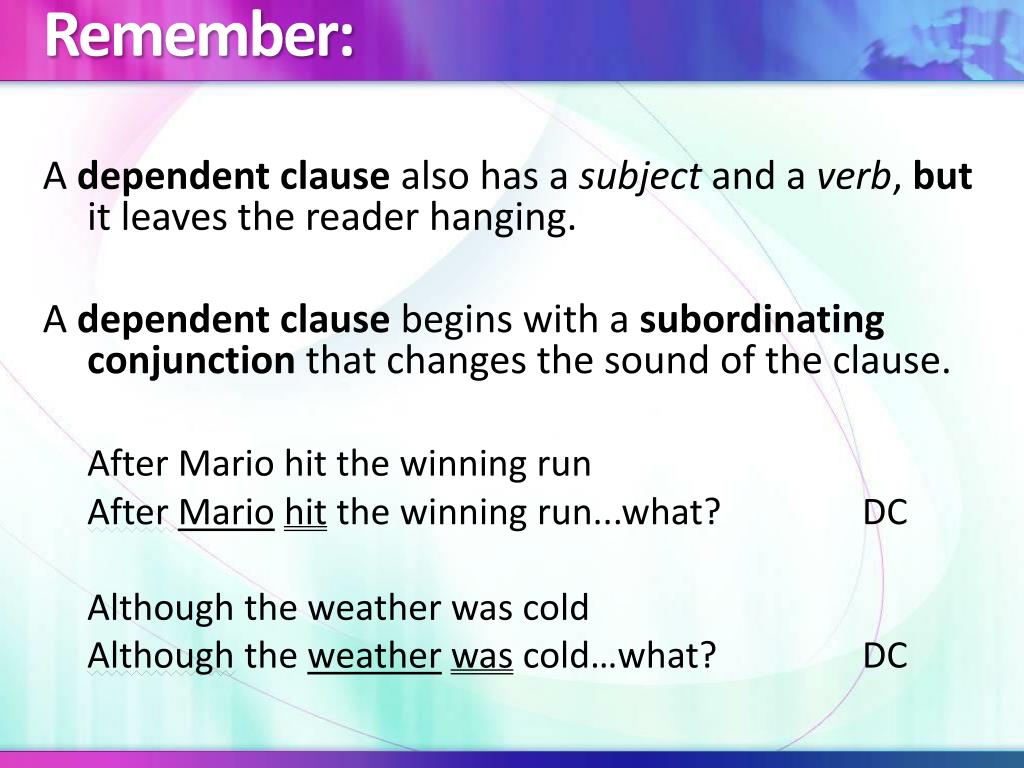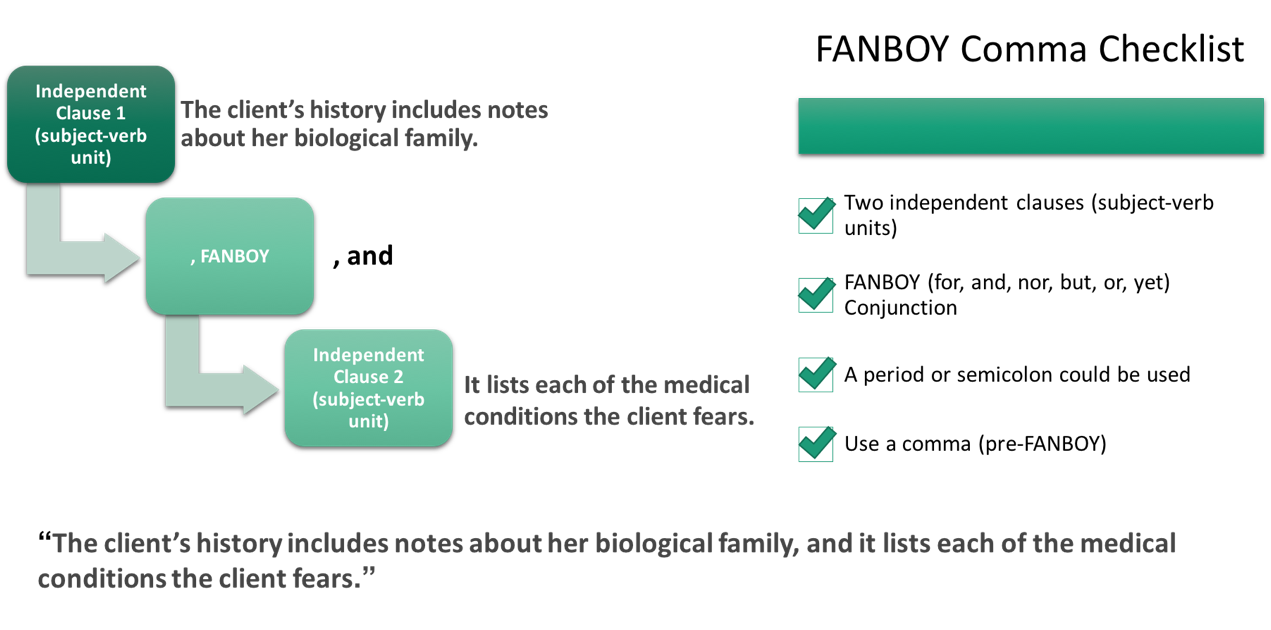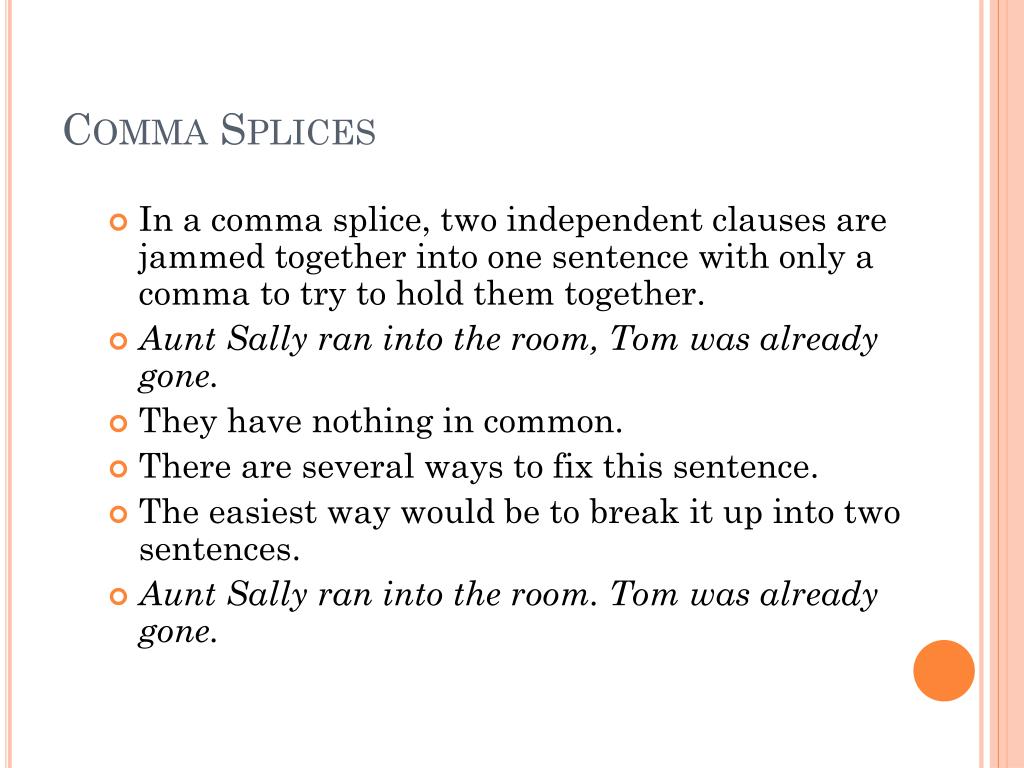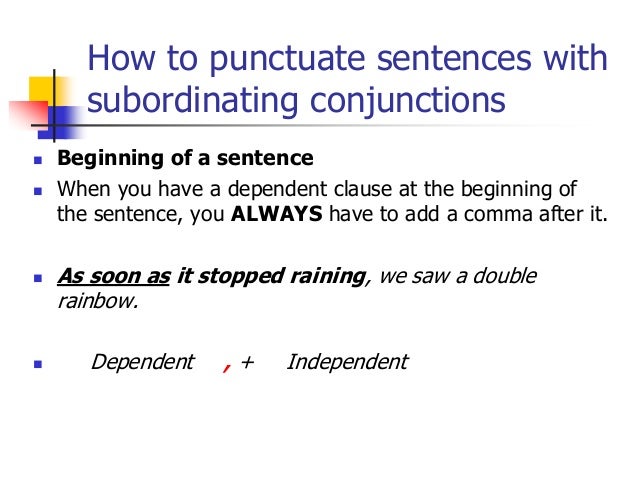If you locate a run-on sentence and find where the two independent clauses "collide," you can decide how best to separate the clauses. Fixing run-on sentences is very similar to fixing comma splices. You can make two complete sentences by inserting a period. You can use a semicolon between the two clauses if they are of equal importance; this allows your reader to consider the points together.
You can use a semicolon with a transition word to indicate a specific relation between the two clauses; however, you should use this sparingly. You can use a coordinating conjunction and a comma, and this also will indicate a relationship. Or, you can add a word to one clause to make it dependent. Once you discover where the two independent clauses are "spliced," there are several ways to separate them. You can use a coordinating conjunction following the comma, and this also will indicate a relationship. For additional information on coordinating conjunctions, click HERE.
See the note BELOW regarding the use of a comma between two independent clauses when the second independent clause begins with a parenthetical element or adverbial clause. A compound sentence contains two or more independent clauses linked by a coordinating conjunction. Independent clauses are those that can stand alone as complete sentences.
The most common coordinating conjunctions are and, but, and or. In certain cases, nor, yet, so, and for act as coordinating conjunctions. Another possibility is that a writer is punctuating by ear, relying on the old idea that you put a comma where you take a breath. Since but signals a disjunction, a writer might imagine a pause and insert a comma on that basis. But punctuation is not determined solely by pauses heard in our mental ear. If pausing is the basis for the comma after but, we are dealing with a false underlying assumption leading to an error.
Listing commas can separate lists of nouns, verbs, adjectives, dependent clauses, or even complete sentences. This can mean that you can have a comma before an "and" that is followed by a dependent clause if it is the last item in a list of dependent clauses. Some authors like to join sentences with listing commas, e.g.
An independent clause is a unit of grammatical organization that includes both a subject and verb and can stand on its own as a sentence. In the previous example, "I went running" and "I saw a duck" are both independent clauses, and "and" is the coordinating conjunction that connects them. Some students are unfamiliar with the definitions and rules of clauses and punctuation, the basic building blocks of sentence structure.
This problem does not show itself too much when you write in the first person voice ("I remember once . . .") because that is your natural idiom. In some ways, it seems like trying to write in a foreign language. A group of words that can easily serve as a separate sentence is called an independent clause. As you may recall from above, an independent clause has a subject and a verb and can stand on its own as a sentence. Often, a coordinating conjunction will connect two independent clauses — like the word "but." Though not necessarily mechanical, the use of commas in lists is well established.
In this usage, the comma separates a series of words, phrases, or independent clauses. Contending that the coordinating conjunction is adequate separation, some writers will leave out the comma in a sentence with short, balanced independent clauses . If there is ever any doubt, however, use the comma, as it is always correct in this situation. A comma indicates a pause between the ending of an introductory word, phrase, or clause, and the beginning of the main part of the sentence. The most common introductory word groups are clauses or phrases which function as adverbs, telling how, why, when, where, or under what conditions something happened. Other introductory elements may include prepositional phrases, adjective clauses or phrases, participial phrases, infinitive phrases, and transitional expressions.
Commas can be used to separate independent clauses, but with the addition of a coordinating conjunctions . A compound sentence must have two independent clauses – not just two verbs, two nouns, or two groups of words that are not independent clauses. Writers can give readers information that limits or otherwise modifies a main idea that follows. To do so, writers can use introductory words or introductory phrases. These introductory elements can be one word or several.
Common introductory elements include transition words and statements about time, place, manner, or condition. Coordinating conjunctions are conjunctions, or joining words, that are placed between words and phrases of equal importance. Used with coordinating conjunctions, commas allow writers to express how their complete thoughts relate to one another.
They also help avoid the choppy, flat style that arises when every thought stands as a separate sentence. Semicolons (;) Semicolons are used to connect two independent clauses and to separate items in complex lists. In each of the examples above, the two parts of the sentence separated by the comma could stand as full sentences by themselves. It's important to check that the coordinating conjunction is really joining two independent clauses and not two phrases. In the preceding examples, note the comma after sister and late.
Nonessential words, clauses, and phrases that occur midsentence must be enclosed by commas. Following are two instances of the need for an appositive comma with one or more nouns. Many inexperienced writers run two independent clauses together by using a comma instead of a period. This results in the dreaded run-on sentence or, more technically, acomma splice. You should always have a comma before FANBOYS that join two independent clauses .
Look carefully at the next two sentences to see two independent clauses separated by comma + FANBOYS. A simple sentence contains only one independent clause and no dependent clauses. When a simple sentence contains a conjunction, you might be tempted to insert a comma before the conjunction, as you do with a compound sentence. With a simple sentence, however, the general rule is to omit the comma. Sometimes subjects are separated from verbs by nonrestrictive clauses, words like however, or other interruptions. A compound sentence contains more than one independent clause.
The clauses can be joined by a semicolon, a colon, or a coordinating conjunction . When you're writing a list of nouns, verbs, or any other part of speech, you'll need to include commas to separate them. There's no comma here—because now there is only a single clause. A rule of thumb is to check to see if there is a subject explicitly stated with each verb. If two or more verbs go with the same subject, you don't need a comma because you don't have multiple independent clauses.
If both the independent clauses are short then some writers may choose to omit the comma before the "and", but you will never be wrong to use it. So if you're not sure then I advise you to include it. Review the information on run-on sentences for examples of correctly joining independent clauses. Place a comma before a coordinating conjunction that joins two independent clauses . Remember to put the comma before the conjunction, not after. When a coordinating conjunction joins two independent clauses, a comma is used before the coordinating conjunction .
Sometimes, we want to link two independent clauses together without using "and" or "but," or any other coordinating conjunction. A comma marks a slight break between different parts of a sentence. Used properly, commas make the meaning of sentences clear by grouping and separating words, phrases, and clauses. Many people are uncertain about the use of commas, though, and often sprinkle them throughout their writing without knowing the basic rules. Use a comma to separate the elements in a series , including the last two. "He hit the ball, dropped the bat, and ran to first base." You may have learned that the comma before the "and" is unnecessary, which is fine if you're in control of things.
However, there are situations in which, if you don't use this comma , these last two items in the list will try to glom together . Using a comma between all the items in a series, including the last two, avoids this problem. This last comma—the one between the word "and" and the preceding word—is often called the serial comma or the Oxford comma. In newspaper writing, incidentally, you will seldom find a serial comma, but that is not necessarily a sign that it should be omitted in academic prose.
Commas are necessary before a coordinating conjunction that separates two independent clauses. To join two closely related independent clauses that are not joined by a coordinating conjunction. A comma before "if" is necessary when it comes after an introductory remark at the beginning of a sentence. We also need a comma when "if" is used after a mid-sentence transition phrase such as "for example" or "that is". And, we also need to place a comma before "if" when it introduces a parenthetical remark either halfway through or towards the end of a sentence. However, a pre-comma would be incorrect when "if" introduces a subordinate clause after the main clause, as well as when it functions as a noun.
But, when the sentence is clunky, and therefore hard to read without the comma, we can optionally place one to improve readability. Two independent clauses should never be joined by a comma alone. Moreover, it's clear that when people want to use punctuation artistically, most of the time they strip it out . The writing flows through good choice of words, leaving out what other writers would choose to -embellish, and getting to the heart of their characters.
As a reader, I don't read commas as pauses, so using them isn't going to work in the way you want them to work. In this sentence, each clause either side of "but"—"I want to buy a new car" and "I don't have any money"—could work as a sentence on its own. This means they are independent clauses, and it is correct to use a comma before but. Introductory clauses and phrases are groups of words that come before an independent clause in a sentence. When you start a sentence with a dependent clause, you follow it with a comma (just like that sentence!).
The comma functions as a tool to indicate to readers a certain separation of words, phrases, or ideas in order to prevent misreading the writer's intended meaning. When a sentence is spoken aloud, a comma often represents a pause, which in verbal conversation functions to clarify meaning. The comma is used according to specific rules that relate to grammatical structures within the sentence. Consistency in the use of commas allows the reader to be assured of proper interpretation of the writer's intentions. The words "whereas" and "although" are subordinating conjunctions. The general rule for subordinating conjunctions states that you shouldn't use a comma before a subordinating conjunction that comes after the main clause.
However, "whereas" and "although" are examples of "adverbs of concession," along with "though" and "even though". They are used where a dependent clause is contrasting to the main clause (a bit like "but"). You should use a comma to introduce a dependent clause that starts with an adverb of concession. When joining two independent clauses with a conjunction, place a comma before the conjunction. Conjunctions include the words "and," "but," "or," "nor," and "yet." In sentences where two independent clauses are joined by connectors such as and, or, but, etc., put a comma at the end of the first clause.
Two commas can be used to set off additional information that appears within the sentence but is separate from the primary subject and verb of the sentence. Sometimes called a "parenthetical expression" or an "aside," this information interrupts the main thought to add an additional comment. Occasionally, the interrupter won't actually interrupt the main thought.
In that case, it's preceded by a comma and followed by a period. In English, commas are used to separate parts of sentences. Use a comma to separate elements of a list, distinguish groups of words that go together, mark conjunctions between complete thoughts, and more. This handout offers seven easy steps to deciding when to use a comma.
In this case, there is no comma separating the two because we do not pause between them in speech. What makes a clause "dependent" is the "subordinating conjunction." Common subordinating conjunctions include "while," "because," and "although." (i.e., one with two independent clauses joined by the conjunction but), the rule for which is to insert a comma before the conjunction.
A complex sentence contains an independent clause and one or more dependent clauses. A dependent clause, unlike an independent clause, cannot stand on its own as a complete sentence. The conjunctions and prepositions most commonly used to introduce a dependent clause include if, because, while, as, although, since, and unless.
The two independent clauses are separated by a comma and the word and. Both clauses are independent and could stand on their own as complete sentences. When they are joined in the same sentence, however, they must be connected with a comma and a coordinating conjunction. When joining two independent clauses, or clauses that could stand on their own as full sentences, place a comma before the conjunction.
If the second independent clause is very short, or if it is an imperative, the comma can be omitted. A comma splice is a sentence that has two or more independent clauses joined only by a comma. If the independent clauses are not joined by a conjunction, i.e., and, or, nor, but, etc., then the correct mark is the semicolon (;), see more under . You also need to add commas around appositive phrases, which function like relative clauses but don't include relative pronouns. Unless you're starting a sentence with an independent clause, it's safe to assume that you need a comma. Otherwise, it's difficult to know when your introductory clause or phrase ends and the rest of your sentence begins.
However, when you add another independent clause with a coordinating conjunction , separate them with a comma. When you're writing a simple sentence, you're using only one independent clause. A nonrestrictive element describes or adds additional information to the noun or pronoun whose meaning is already defined or clarified.
Therefore, because it contains information that is not essential to the main point of the sentence, a nonrestrictive element is set off by commas. When using a vocative in the middle of a sentence, make sure that you're not actually creating a comma splice by joining two independent clauses. When a time phrase adds information to an independent clause or sentence that follows it then it should be followed by a comma.


























No comments:
Post a Comment
Note: Only a member of this blog may post a comment.